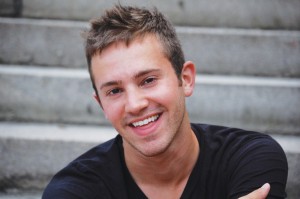
SpeakOut: What Is Pride?
 It’s more than the dictionary definition.
It’s more than the dictionary definition.
by Blake Hayes
“The next time someone asks you why LGBT Pride marches exist or why Gay Pride Month is June, tell them ‘A bisexual woman named Brenda Howard thought it should be.’” (Quote attributed to bisexual activist Tom Limoncelli, who is also a 2006 recipient of the Brenda Howard Award from PFLAG.)
Do you know who Brenda Howard is? That’s okay, I didn’t either, until I started to write this month’s column and search for an answer to the question: What is Pride?
“Justifiable self-respect” (the dictionary’s answer) is a good place to start.
Pride is certainly about standing up and saying, “I am gay, and I deserve to be equal, and here I am!”
But LGBT Pride is also about history, and remembering how our progress was made. Pride parades, after all, began as a modest commemoration on the first anniversary of the 1969 Stonewall Inn Riots, which took place at that gay bar on Christopher Street in New York City. And though we’ve made progress on equality, each year we’ve forgotten more and more of our history.
So this year, as we celebrate the forty-fourth anniversary of Stonewall, and the forty-third anniversary of Christopher Street Liberation Day, let’s honor some of our early liberators.
Brenda Howard is one of them. This openly bisexual New Yorker helped create what we know today as Pride. She was one of the core activists who coordinated that first Christopher Street Liberation Day March in 1970. She and her contemporaries popularized the early use of the word “pride,” and initiated the idea of a weeklong series of events each year. PFLAG began giving an annual award in her honor after she died in 2005. Brenda Howard, “The Mother of Pride,” fought for equality for more than three decades. We should all know who she was.
José Sarria is another. He preceded Harvey Milk as an openly gay candidate for office. Sarria’s life is fascinating: born in the 1920s, Sarria had a surprisingly open-minded family who embraced his love of dressing up in girls’ clothes. He entered the military after the attack on Pearl Harbor, skirting the height requirement (he was not quite five feet tall) by seducing a major at the San Francisco recruiting station!
Later, Sarria would become a beloved drag queen at the Black Cat Bar in San Francisco. He used the position to encourage customers to live openly and stand together, becoming increasingly active against the bar raids and other discriminatory police action.
Eventually, Sarria turned in his heels for a suit and ran for the San Francisco Board of Supervisors. He didn’t win, but he did show the power of the gay vote and paved the way for future LGBT candidates across the country, including Harvey Milk. Sarria continued to remain active in the fight for equality, and as far as I can tell, is still alive and living in New Mexico.
With his campaign in San Francisco, Sarria became the first openly gay candidate for office in the United States. It was 1961. Every gay person in America should know who he is.
There are so many others: Gilbert Baker, who created the rainbow Pride flag (did you know it originally had eight colors?). Cleve Jones, a tireless activist who worked on Harvey Milk’s campaigns and went on to create the AIDS Quilt. Craig Rodwell (whose first serious relationship was with a young Harvey Milk), who, along with Brenda Howard, proposed the first Pride parade as “a nationwide show of support.” His Bleecker Street apartment was where the first march was planned.
Finally, this last name is the one that I have a personal connection to: Medora Payne. I found her (okay, I stalked her) on Facebook, and we’ve kept in touch for a couple of years now. Her part in the LGBT civil rights movement is much smaller than the other giants I’ve listed here, but it’s no less important. She is a mom, a teacher, and a staunch ally of ours.
I found her shortly after reading what should be a required text for LGBT Americans: The Mayor of Castro Street: The Life and Times of Harvey Milk.
In one passage, early in the campaign, author Randy Shilts writes: “Ryckman [Milk’s new campaign manager] knew he had made the right decision a few days later when a half-giggling store employee told him a new campaign volunteer had arrived at the Castro Camera headquarters. At the counter stood a pert young girl in her Most Holy Redeemer uniform, a wool hat, and a school bag. Ryckman thought she might be a midget, but no, she was a sixth grader who had carefully printed out the volunteer card:
Name: Medora Payne
Age: 11.”
I’m so honored to have found Medora, who has provided me with a small, indirect connection to Harvey Milk’s legacy.
This, to me, is what Pride is. It’s reaching back and connecting with our history. As LGBT Americans, we’re not really a part of the curriculum yet, so it takes a little more effort to discover that history, but it’s there.
From the eleven-year-old campaign volunteers to the fallen heroes whose memory we honor, keep them all in the back of your mind this month, and stay focused on the progress we still have to make.
And if you have the “justifiable self-respect” to rock some skimpy outfit on a parade float, you go ahead and do it, and I’ll cheer you on. Just don’t forget the other half!
Happy Pride!
Blake Hayes is the morning host at Mix 96.5 KHMX.











Comments